
As a kid who grew up on Star Wars, and who loves the original Star Wars more than anything, you would think that A New Hope would be the most memorable movie from my childhood. But that actually isn’t true. Both Empire Strikes Back and Return of the Jedi were more memorable.
The reason for this is, Star Wars began a new expectation in Hollywood that, with each new blockbuster film, you were going to see things you had never seen before. And when I went to those sequels, that’s exactly what happened. I saw AT-AT walkers and tauntauns. I saw aliens with lobster heads and speeder bikes shooting through gigantic trees.
Back then, Star Wars was the defining franchise for Hollywood’s new mantra: GIVE THEM SOMETHING NEW AND FRESH. Every movie that had aspirations of being a hit had to give audiences something genuinely new. It’s why Jurassic Park did so well. It’s why Men in Black and Independence Day and The Matrix and Aliens did so well. Hollywood operated off of this idea that why would someone see a movie if all you were going to give them was something they’d already seen?
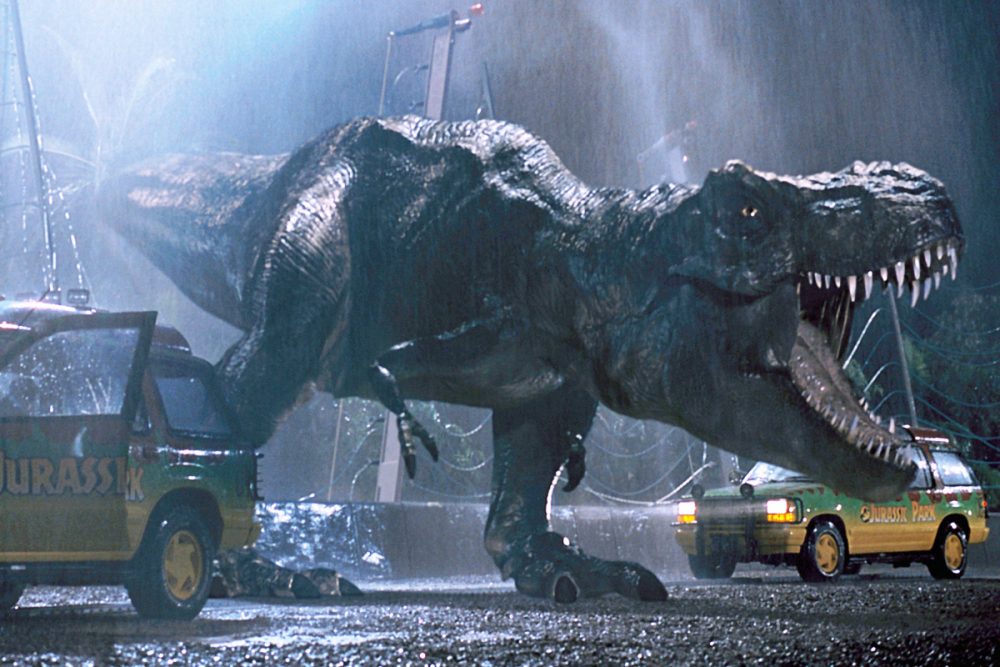
But somewhere around 2005, when comic book movies started to take over and special effects companies were able to create anything you could imagine, it all of a sudden became a lot more difficult to give audiences something new. Once you have a man in an iron suit fighting a giant green monster in the sky or five-story tall robots hurling each other into city buildings… what can you really show audiences at that point that they haven’t seen?
Marvel realized that this was going to be a problem. Whether intentional or not, they had opened up Pandora’s Box. How do we tempt audiences to come to theaters when we’ve already given them everything? They’ve come up with a temporary solution. More superheroes. You cram more spidermen, more Avengers, and more surprise guest caped crusaders into your flick, because, technically, you are still giving audiences something new. You’re giving them more superheroes to play around with.
And Marvel has a quasi stay of execution since they now own 20th Century Fox. People are going to be excited to see the X-Men hanging out with Thor. They’re going to be excited to see the Silver Surfer cutting a jib with Starlord. They’re going to love when the Fantastic Four goes on an adventure with Spidey. But eventually, even that will peter out. At a certain point, people are going to say, “What’s new? What’s next?”
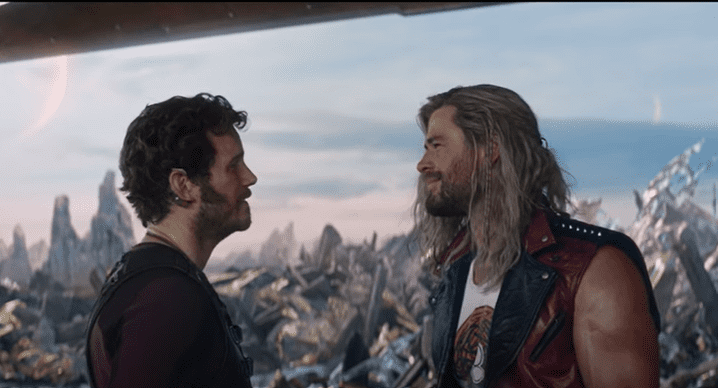
I think about this a lot because you – as in you, reading this article right now – are the solution to this problem. It will be up to you to come up with the next big thing. The question is, is it possible to come up with the next big thing anymore? Is it possible to shock readers anymore? Is it possible to show them something they’ve never seen before?
As someone who reads pretty much everything, I can’t remember the last time I read something totally fresh. I’m not even talking about the whole script. I’m talking about one set piece I haven’t seen before.
There are scripts that are KIND OF unique. Colin Bannon, who wrote yesterday’s script, for example – he wrote a script about ultra marathon runners who participate in a death race where an evil mythological creature kills the runners one by one. Have I ever come across that specific concept before? No. But I’ve read plenty of scripts where people get killed by a creature in the woods.
Which leads us back to the question, can writers come up with anything truly new? Like an AT-AT Walker attack on a snow base in 1982?
Probably not. But that doesn’t mean we can’t still write movies that wow a reader or an audience.
And by my estimation, there are still two ways to do that.
There’s a way for the ultra-talented screenwriter. And there’s a way for the workhorse screenwriter.
For the ultra-talented screenwriter, the answer is A UNIQUE VOICE. Back in the 90s, concurrently with all these big Hollywood movies that were giving us stuff we’d never seen before, the indie scene was also giving us stuff we’d never seen before, but not through big expensive effects, like dinosaurs. But rather through their own unique lens. Tarantino, Paul Thomas Anderson, Spike Lee, Charlie Kaufman, Wes Anderson. They would lead us into the 2000s where we got Diablo Cody, Alan Ball, Alfonso Cuarón, M Night, Edgar Wright, and Jordan Peele. These writers showed us the world in ways we had not seen on film before.
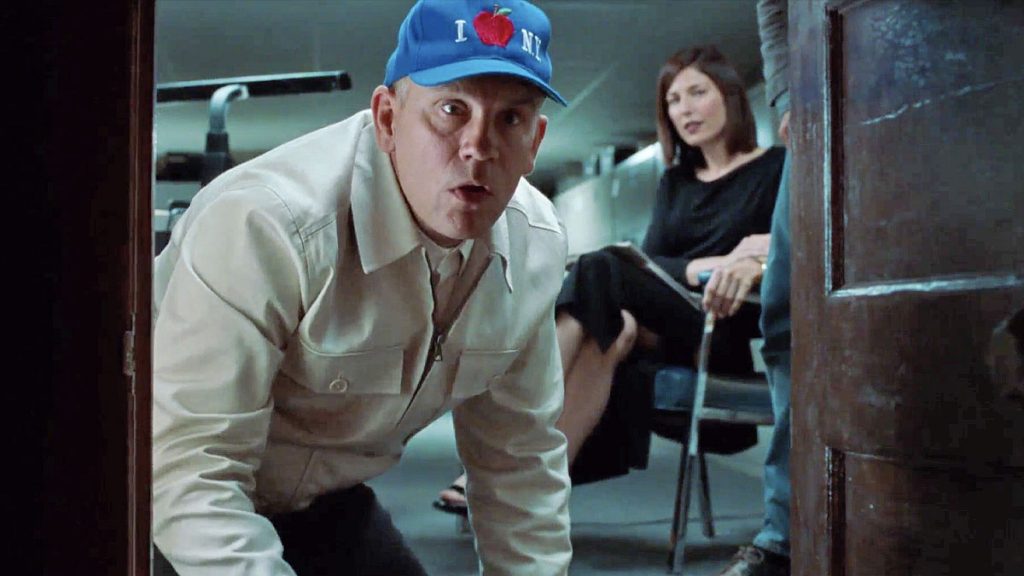
You can’t really strategize a voice. Your voice is inherently yours so you can’t change it around. But voice tends to break out when it’s different from what we’re used to seeing. That’s the whole point of today’s article. You’re giving them something new. So if you’re writing “male romantic comedies” at a time when Cameron Crowe was the biggest screenwriter in the world, your unique voice probably isn’t going to be appreciated, since there’s already a strong voice dominating that sub-genre.
But nobody knew what hit them when Charlie Kaufman started getting movies produced. We’re in John Malkovich’s head?? What the hizell is going on right now??? Ditto Diablo Cody. We hadn’t heard heightened dialogue that fun and lyrical since John Hughes. Nobody else was doing that at the time.
Fortunately, if you’re one of the lucky lottery winners who have an industry-changing voice, you don’t need this article. You’re probably going to be okay. So let’s switch over to what the workhorse writer can do.
First off, like I said, you should still be trying to come up with new ideas. Whether it be concepts or set pieces or even an idea for a scene that’s never been done before (the opening sequence from Promising Young Woman, where the prey shockingly becomes the predator, for example). The more “new” you can get into your script – even if it’s not world changing new like an Old West bar full of aliens, you should include it. Cause all those little *slightly new* things add up.
But here’s where you should really be focusing. Because this is the hack that will allow you to write even a traditional story that people fall in love with.
The way that the workhorse screenwriter can circumvent the blueprint is to write a great main character into their script. And let me explain why. When a reader falls in love with a character, they don’t care that much about anything else but following that character around and seeing what happens to them.
This is the secret sauce that will work now and until the end of time. It is the reason why, even though we in the movie business can no longer provide audiences with things they’ve never seen before, we can still make them feel things. We can still jack into their emotional circuit board and take them on a ride that will feel just as powerful as their last relationship. That will fill them with just as much love and pain as the trials and tribulations they go through with their own family. And when they finish that ride, they will feel a much deeper connection to that film than all the CGI dinosaurs combined.
Okay, Carson, that’s great. Write a great character. Duh. That’s still really hard to do, though.
It is hard. But, at this point, it’s way more doable than trying to create something nobody’s ever seen before.
So let me give you two recent films that achieved this that you can learn from. The first was Joker. And the second was Everything Everywhere All At Once.
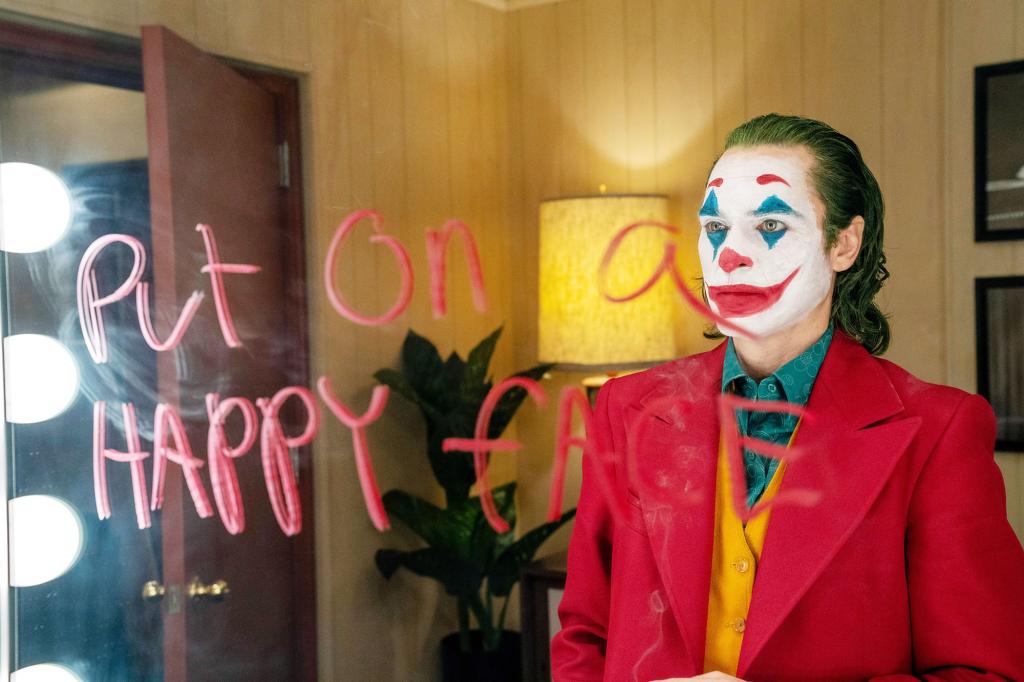
Joker, more than any movie in the last ten years, proved that if you focus on creating a really compelling main character, you don’t need anything else to be new. And you don’t need big fancy effects either.
The reason Arthur (the Joker) worked is because the movie made him sympathetic – someone who was picked on and made fun of wherever he went. He had a mental condition, which created more sympathy. We liked him because he took care of his mother. But also, we saw how difficult that was for him and how it shaped him (limiting his opportunities to create a social circle), adding complexity. He was an underdog in his pursuit of the pretty girl who lived in his building. So we rooted for him.
But here’s where the character took off. Cause if you stopped there, you could’ve placed that character in a romantic comedy. The reason the character becomes iconic is because he hates the world and he starts to have a severe mental breakdown. Going so far as wanting to hurt innocent people.
Severe contrast within a character (you’ve got this really good stuff and this really bad stuff swirling around in the same body) is often what makes them compelling and interesting to watch. And Arthur Fleck had that in spades. We wanted to watch him to see what he did because what he did was usually interesting.
Everything Everywhere All At Once was a completely different beast in that it was an ensemble piece and it actually was giving us bits and pieces of “new” (I mean, there’s a universe where everyone has hot dog fingers). But where the film really excels is in its characters.
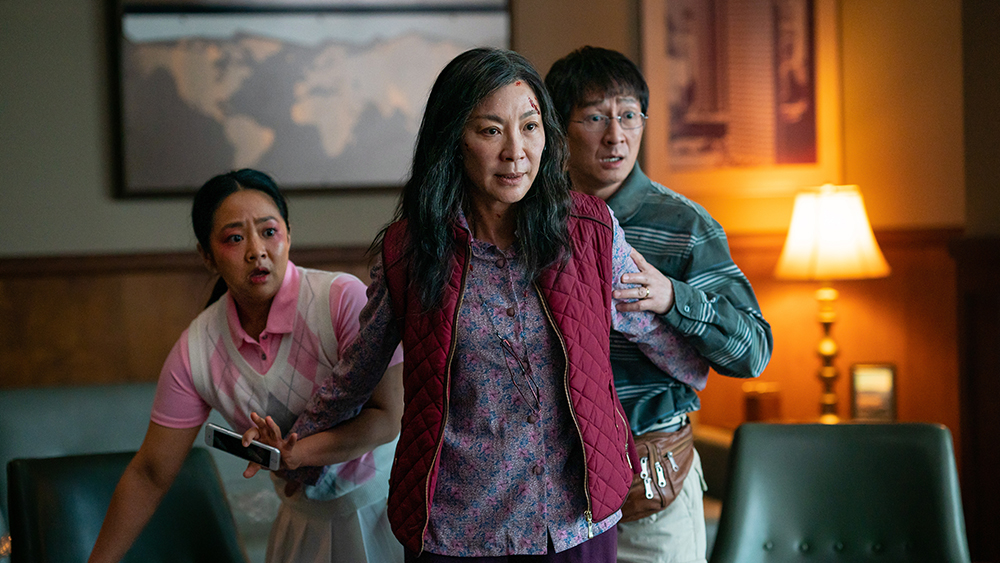
The mother, Evelyn, has this really complex backstory where her father warned her not to marry this wimpy man. She ignored him and did anyway. And it turns out her father was right. Her husband never amounted to anything and, because of this, she’s 60 years old and managing a crappy laundromat that’s being held together by rubber bands and popsicle sticks.
She’s got a daughter who’s gay and it’s really really hard for her to accept that. If you slide over to the husband’s storyline, he loves his wife more than anything and is dealing with the fact that she wants to divorce him. She’s loveless. He’s hopeless. The daughter is miserable. And all of that stuff is rooted heavily in a backstory that was extensively reserached because it had to be since the movie would explore hundreds of different versions of that same backstory in other universes.
The climax of the movie is not a big fancy Marvel showdown but rather, by the Daniels’ (the directors) own admission, an “empathy fight.” It’s this family trying to connect for the first time in years.
I bring this example up because it would’ve been easy to write paper-thin characters and just focus on the fun kung-fu and multiverse gags. By making sure the characters were all complex, it turned a movie with a wacky concept into something that will stay with you for the rest of your life.
THAT’S WHAT YOU NEED TO BE DOING.
Create characters with interesting well researched backstories, who have intense unresolved inner conflict, and who also have unresolved conflict with other characters in the movie, who, to the best of your ability, you give the same fully-fleshed out treatment to.
Cause if you can write characters we love (the husband in Everything Everywhere) or are fascinated by (Arthur Fleck), those characters will get their hooks in the reader/audience, and everything else about the script becomes so much easier to pull off.
To summarize, if you’ve got that idea that nobody’s seen before, great. Write it. If you’ve got that set piece or scene that nobody’s seen before, great. Write it. As I’ve said before, producers will buy a script if it has one amazing “going to look great on screen” movie scene. If you don’t have either, try to include as much “kinda new” stuff as you can in your script. Cause it adds up. Finally, even if you don’t have a single new thing in your script, you can still write something great if you have a great main character or a cast of extremely strong characters. Unless you’re the next David Lynch, character-creation is your biggest weapon as an unknown screenwriter. Now go use it!
*********************
SPECIAL DEAL!!!!
Two script consultation slots just opened up this week. So I’ve decided to offer two SUPER-DEALS. 4 pages of notes on your feature or pilot for just $199. That’s 60% off the feature rate and 50% off the pilot rate. I know that half of you will be asleep when I post this, so here’s what I’m going to do. The very first person who e-mails me RIGHT NOW at carsonreeves1@gmail.com the word, “DEAL,” gets the first deal. And then, whoever e-mails me first starting at 9am Pacific Time tomorrow (Thursday), gets the second deal. This is a rare opportunity. If you’re someone who’s always held back because my consultations don’t fit your budget, this is the time to strike!
*********************
John Wickan?
Genre: Action/Supernatural
Premise: When an elite assassin is sent to the haunted Harz Mountains in Germany on an extraction job she intends to be her last, she quickly learns that the local legends about witchcraft are true and must face a sinister supernatural threat.
About: Colin Bannon is quickly climbing the Hollywood literary ladder, unleashing tons of big idea scripts into the machine, which is gladly snatching them up. He already sold that Squid Game-inspired spec about a secret Russian marathon where only the best runners are invited, and then killed off over the course of the race. Will John Wickan be his next sale?
Writer: Colin Bannon
Details: 112 pages
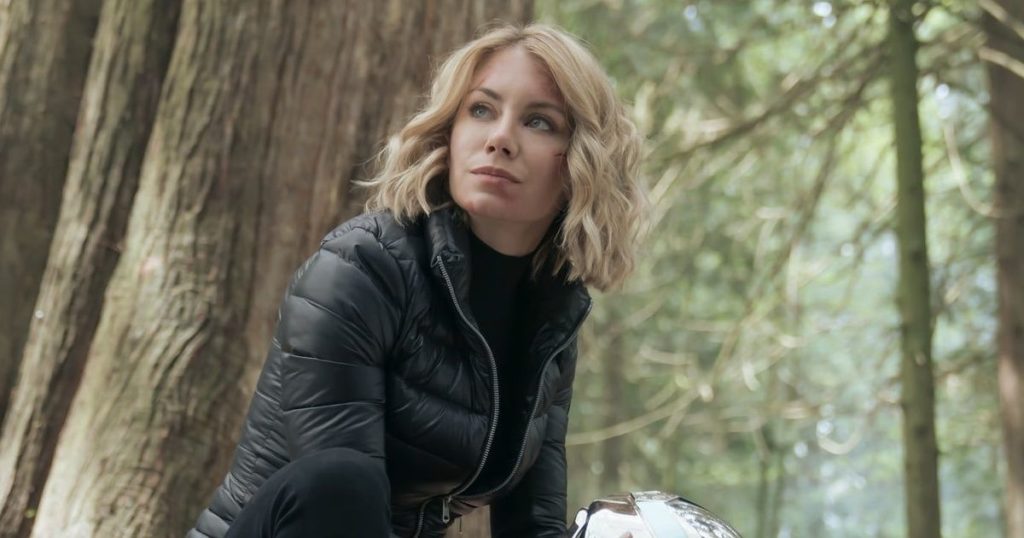 Peacemaker’s Jennifer Holland for Six?
Peacemaker’s Jennifer Holland for Six?
You gotta give it to Colin Bannon. The guy is a high concept generating machine. We already looked at one super high concept 2021 Black List entry of his. This is the other one.
While I love Bannon’s infatuation with big ideas, I think he gets a little too crazy as his scripts go on. They feel like chaos. And it becomes harder and harder to see through that chaos to find the story.
There’s something to be said there about writer blind spots. Every writer has them and I used to think that if you told a writer over and over again that Issue X was a blind spot of theirs, they’d eventually fix it.
But an argument can be made that every writer *is* their blind spot. Has Christopher Nolan ever shored up his excessive exposition? Is Joss Whedon capable of not writing quippy dialogue? Is it possible for Judd Apatow to write a movie that stops at 3 acts?
I remember one of my giant weaknesses that never seemed to go away was when I got a man and a woman in a scene — didn’t matter the genre — it would always end up reading like romantic comedy banter. Even though I *knew* it shouldn’t read like that, it still read like that. The price of growing up in the Romantic Comedy Golden Era I suppose.
While these weaknesses tend to be a part of our “voice,” I do think that, as an artist, you should always be trying to improve, and one of the best ways to improve is addressing recurrent criticism.
With that in mind, let’s check out The Devil Herself.
Six is an assassin in her 30s who lives in the middle of nowhere for reasons we’ll find out have to do with her former organization wanting to kill her. But Six is tired of living a life of seclusion and wants to move to “The Island,” a place where “Numbers” go to retire (and subsequently, can’t be assassinated).
So she catches up with an old friend, Two, who tells her that he can get her to the Island, but she’ll have to do something for him first. A 7 year old girl has been kidnapped by some creepy people who are currently holding her in a church on the highest mountain in Germany. Go get her, return her to her mom, and you can go to the Island.
Six zips up the mountain, charges into the church, and finds some crazy Pagan ritual going on, the center of which is the young girl, Petra. Six starts firing away like Rambo, scattering the witches, which include the freaky High Priestess, grabs Petra, and drives her back to her mother.
Just two minutes into the reunion, there’s a knock on the door. They answer and and see Aunt Alice. Except Aunt Alice looks a lot like the High Priestess. Six scans her up and down. Is it the High Priestess?? It’s hard to say without all the blood and robes she had on before. But Six wants to get to that island so she heads out.
She doesn’t get a mile before slamming on the breaks, turning around, and burning rubber back to the house. By that time, the entire family is dead or near-dead, and “Aunt Alice” and Petra are gone. Six hurries after her, shooting Aunt Alice’s van off the mountain with a sniper rifle, then going to retrieve Petra from the wreckage (yes, you read that right).
Once she has Petra again, she realizes that those crafty witches were able to put a demon in her. This means Six will have to transport Petra to a White Magic expert who can exorcise the demon from the girl. Complicating matters is that Six’s old boss, One, has found out where she is and sent every assassin in the area to kill her. Talk about a rough day at work!
Last week I lamented the creative choice to build a show around a man who strangled a goose. This week says hold my beer, and also my shot of tequila, and also this liquor store I just happen to be carrying in my backpack, and proceeds to start with a woman shooting dead a baby deer.
Why do I get the feeling Bannon will not be called in for Disney’s inevitable live-action remake of Bambi?
Bannon: “Okay, so hear me out. We start on Bambi right? And she’s sipping water from the lake. It’s serene. There’s not a cloud in the sky. And then BAM!!! An alligator bursts out of the water and decapitates Bambi with one chomp of his mouth. What do you think? Cause it doesn’t have to be an alligator. Maybe Bambi just falls into the lake and drowns? That could be good?”
Okay, so Six shot the fawn by mistake but still. Not sure you want to start your movie on your hero killing a baby deer.
What follows is, what I’ve come to now know, as “The Bannon Factor.” The Bannon Factor is when you take whatever would normally happen and multiply it by 100. For example, every day in her little shack, Six works out. And she’s got a picture of the Island on her wall. This is what’s written in the scene: “She’s doing sit-ups now. There’s only one decoration pinned to the wall — A lone photograph of a TROPICAL ISLAND. With every rep, she glances at the photo.”
Does she have to look at the picture *EVERY* rep? Can’t she just look at it a few times and get back to focusing on her form? It’s a little on-the-nose to have her look at her island picture for 200 sit-ups in a row… EVERY DAY.
This excessiveness bleeds into his overall style of writing as well. And it’s there on every single page. You don’t get any breaks. Here’s a typical page from The Devil Herself:
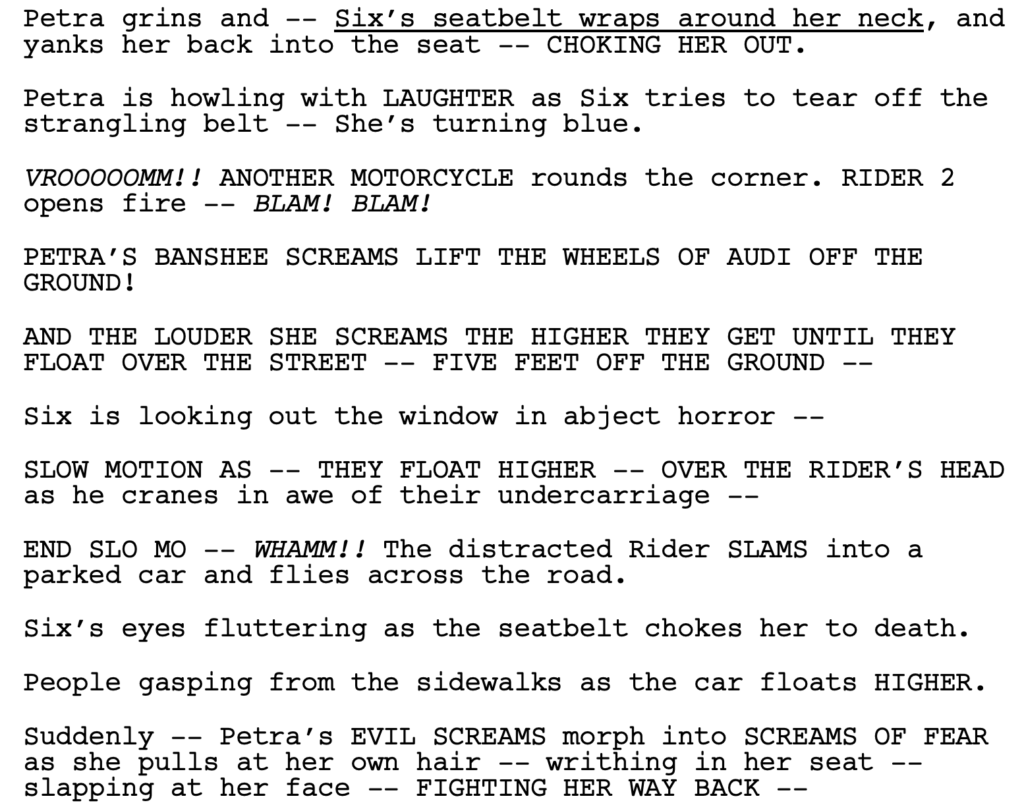
The act of reading is not unlike the act of living. People like variety. They like to work out intensely for an hour, then veg out in front of their TV for a little bit. They like to party with friends at night. They like to go on serene hikes in the mountains during the day. If you do the same thing every day all day, with zero variety, you eventually go insane!
And I realize there may be some confusion here because spec scripts are supposed to move fast. But “fast” doesn’t mean non-stop action. I can read a script with two characters falling in love that’s mostly dialogue that reads “fast.”
Yes, you want to move your plot along. But unless you add some variety to your scenes, everything starts to look the same. Predictability is a script-killer. It really is. The second the reader knows where things are going to be 10 pages from now, and 10 pages after that, and 10 pages after that, that’s when they check out. Because what’s the reason to keep reading if you already know what’s going to happen?
Now are there “all-action” movies that work? Yeah, sure. Mad Max Fury Road comes to mind. But just because a handful of movies have pulled off the impossible over the last 75 years doesn’t mean you’re going to be able to do it.
With that said, I do like strange genre combinations. I don’t know many action movies that include witchcraft. And I actually think it’s pretty cool to mix those two things. Bannon could’ve even gone further, in my opinion, and made Six a witch. A witch assassin would be awesome. But whether she’s a witch or not, it doesn’t fix Bannon’s blind spot, which is that the script is all chaos all the time. We need some cool down periods and we need more variety. Until that happens, I will always be in conflict with Bannon’s scripts.
[ ] What the hell did I just read?
[x] wasn’t for me
[ ] worth the read
[ ] impressive
[ ] genius
What I learned: I love it when writers use time-tested movie moments, then take the piss out of them. How many times have we seen, for example, a character about to kill another character, that character freeze before they can kill them, then fall over dead to reveal another character behind them who’s just killed them? If you’re going to put those moments in your script, look for ways to either have fun with them or do something a little different. Here, Bannon tackles a very familiar moment we’ve seen in a lot of movies, and adds an unexpected funny twist to it…
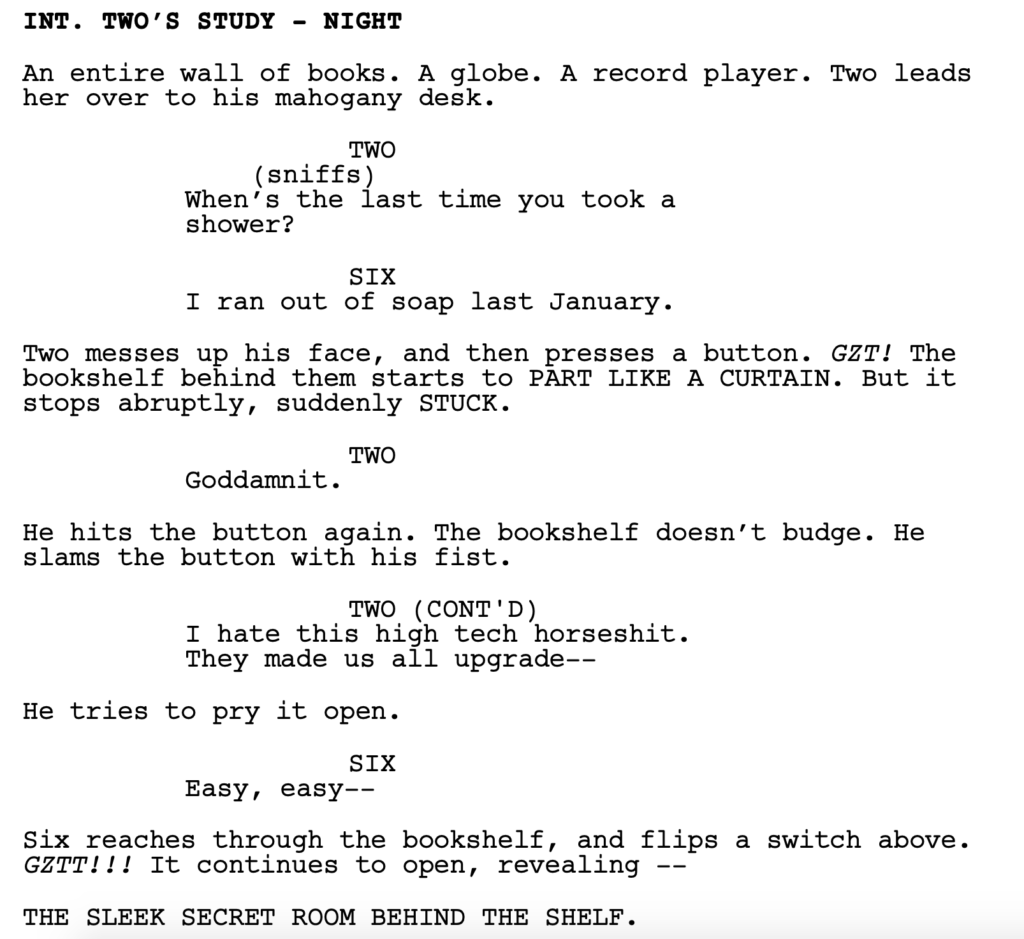
Genre: Action/Thriller
Premise: Shot in the head and left for dead in Tijuana, an international arms dealer wakes up with no memory of who he is, and must figure it out in time to complete a major deal.
About: This is one of the Will Smith slap casualty projects! While Netflix has not officially canceled the film (they’re saying they’ve “slowed development” on it), director David Leitch exited the movie, which was the guy Smith wanted at the helm. Oh, and all of this was announced BEFORE Netflix’s stock value got cut in half. So that would imply that the movie is dead. Then again, so was the hero in Fast and Loose. And guess what? He came back to life! Brother Joe and Erich Hoeber wrote the spec. Their credits include, Red, The Meg, and My Spy.
Writers: Joe Hoeber & Erich Hoeber
Details: 119 pages
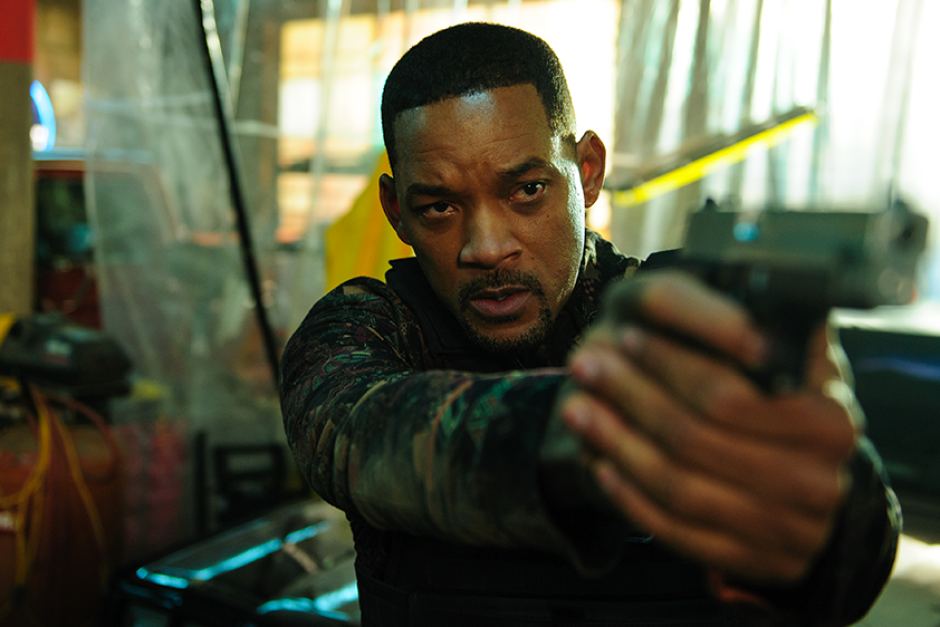
I don’t think there’s a bigger nightmare for a writer than having an A-list star attached to his project in a real way (not one of those shaky attachments, but an *actual* attachment), only for the project to dissolve right in front of their eyes.
Yes, projects fall apart all the time. But this one was solid and it fell apart in the most unexpected of ways. Will Smith decided to become John Wayne for 45 seconds. Imagine if you’re Joe and Erich Hoeber, sitting down to watch the Oscars. Having a few drinks. Grilling a few burgers.
Then…… SLAP! And your project is kaput.
However, when a project gets this much exposure, it’s possible to get a replacement actor. So maybe we’ll still see Fast and Loose somewhere down the line. To its credit, it’s got a nifty Jason Bourne like first act that pulls you in. But what about the rest? Does it work?
It isn’t every day that you wake up in a Tijuana trash sight with a bullet in your head. But that’s what’s happened to Riley. Actually, I’m getting ahead of myself. We don’t know Riley’s name yet because *Riley* doesn’t know his name yet. Riley doesn’t know a darn thing about who he is.
A local doctor takes Riley to his home to help him recuperate. After five long weeks, the doctor gives Riley something he found in his anal cavity. A pod that has in it the name of a hotel in Mexico City. Riley says bye, heads to Mexico City, and is immediately greeted by a shocked hotel manager who takes him to his room.
There, Riley finds three different passports with his picture on them. He eventually finds a “whenever you want to go” plane ticket to London and flies there. Less than five minutes after landing, he’s attacked by two thugs. Out of nowhere, a giant African man named Gerald shoots these men dead and shuttles Riley away.
Long story short, Riley is an international arms dealer and he’s got a team of criminals he works with here in London. But no sooner do we learn that then Riley is approached by a woman named Erin Hardwick who informs Riley that he’s CIA and that this whole arms dealer thing is an undercover job.
Keep in mind, Riley hasn’t told ANYONE he doesn’t remember who he is. He just goes along with the situation, pretending he’s in-the-know. This places Riley in a very unique position. With no memory of his past, both of these lives – CIA agent and International Arms Dealer – are open to him. He gets to choose which one to go with. And the deeper he goes into both, the harder it is for him to make a choice.
This reminded me of that 2011 Liam Neeson movie, “Unknown,” although that script had a better opening. We got to see Neeson’s character check into a hotel with his wife, only to lose his memory after that. Then, when he goes back to the hotel later, his wife has no idea who he is. It was a great first act as the writer very cleverly withheld certain information from us in the opening that led to that “WTF” moment.
Fast and Loose is a little more straight forward. We know almost immediately that Riley is involved in crime. That’s why he was disposed of. So it’s not a surprise when that’s confirmed. It’s slightly surprising when we find out he’s CIA. Though maybe I’ve read too many scripts because I was already thinking, “I wonder if he’s a real criminal or if something else is going on.” Still, it’ll probably be a shock to the average moviegoer.
In addition to this, the script *does* have a compelling question at its center.
If you woke up with no memory one day and found out you were both a super rich criminal with a lavish lifestyle and an undercover CIA agent who makes pennies… which path would you take? Cause remember, you have zero connection to the past. It’s not like you’ve spent 10 years moving up the CIA ladder and making friends with all those people. You have no attachment to anyone since nothing before that shot to your head exists.
What would you do?
It’s a twist on the undercover blueprint we’ve seen so many times before: going undercover then getting just as close to the criminals as you are your fellow agents. That’s the formula that started the whole Fast and Furious franchise.
But here, each side starts off equal. So the decision is a lot tougher. I enjoyed that.
What I didn’t enjoy was the suspension of disbelief required to go along with Riley’s response to the whole thing. You see, Riley doesn’t tell anyone that he’s got amnesia. I guess that sort of makes sense with the arms dealer crew. Who knows what they’d do if they found out you don’t remember anything about them. But he’d definitely tell the CIA. There’s zero reason not to.
Not telling either *does* create a more entertaining dynamic for the movie. But this is a trap all us writers fall into. We want something to happen so bad that we overlook the fallacy of it. We convince ourselves that it makes enough sense to keep in. But it doesn’t make sense in this case and that undercuts the believability of the movie.
The script does offer a great lesson for screenwriters everywhere. This is still a game where you have to get a big actor onboard to get a project moving. So you should always be thinking about things you can do to the character that would make him appealing to actors.
The Hoeber’s do this by creating a Mirror version of Riley. So whenever Riley is near a mirror or any reflective material, a cooler suaver chance-taking version of Riley appears, giving unfiltered advice to Real Life Riley.
After Riley wimps out on killing someone, Inner Riley takes him to task. “Will you just do me one favor? Please?” “What?” “Put you hand in your pants.” “What??” “Put your hand in your pants, fish allllll around, and then tell me if you have any balls whatsoever!”
I would bet my entire left foot that Will Smith signed on due to Mirror Riley. As I’ve established here many times before, actors love opportunities to play different characters in the same movie. And this was a clever way to allow an actor to do that. It was also a great tool to give Riley someone to talk to. This way, he could voice his concerns about what’s going on and have someone to bounce those thoughts off of.
This script seems to be in line with most of the Hoebers’ other scripts. It’s a solid screenplay but it’s definitely not elevated in any way. And so after we realize that he’s a bad guy and he has to make a deal with some Russian kingpin, the script starts to feel like every other action-thriller.
Still, it’s a solid screenplay in that “workmanship” way – screenwriters who know how to deliver a professional script that production, directors, and actors will like.
[ ] What the hell did I just read?
[ ] wasn’t for me
[x] worth the read
[ ] impressive
[ ] genius
What I learned: Any time – and I mean ANY TIME – your character is not revealing something that, in real life, he would reveal? Think long and hard about that choice. Cause I promise you – PROMISE PROMISE PROMISE – any reader is going to be thinking, “There’s no way he wouldn’t say something.” This is the case with Riley not telling the CIA he’s got amnesia. You must be *truthful* as a writer. That means staying truthful to the characters’ actions and decisions. The second you start making characters do things they wouldn’t do in real life, you open the door for readers to check out of your script.
Keep reading to the end to find out what I thought of the Avatar 2 trailer!
Genre: Superhero
Premise: Dr. Strange must utilize the help of a young universe-trotting superhero to defeat a fellow member of the Avengers, who’s turned into a super-psycopath.
About: How is this possible? Dr. Strange 2 pulls in a 185 million dollars! Can Marvel do no wrong? The script was written by Michael Waldron, who became a big deal a few years back when Kevin Feige fell in love with his script, “The Worst Guy Of All Time, And The Girl Who Came To Kill Him,” which I reviewed here. That script got Waldron the “Loki” series. It got him Kevin Feige’s Star Wars project. And it got him this. Of course, as we all know, writers have zero control over these Marvel films. It’s the director calling the shots. And Dr. Strange 2 sees the return of comic book movie directing icon, Sam Raimi.
Writer: Michael Waldron
Details: 2 hours and 6 minutes

We’ve got ourselves a new Marvel movie!
The summer has officially begun.
But has it begun with a whimper or a bang? And do those whispers and/or bangs exist in this universe or another one?
So many questions. I don’t know if I have the answers. But I’m going to give it my best shot!
Okay, I’ll keep this summary short and sweet. And it *will* include spoilers. You’ve been warned.
Dr. Strange is bummed out because the love of his life, Christine, just got married. But no sooner do the wedding bells ring than a giant octopus is attacking the city. So Dr. Strange goes and kills it.
He quickly finds out the octopus is from another universe, a universe that a new superhero, 16 year old Latina, America, opened. America has a special power that allows her to jump between universes.
Flash forward to Wanda, aka Scarlet Witch, who is really bummed out because she’s learned that she has kids in every single universe but this one! Since she wants kids, she wants America, since America can get her to these other universes where she can be with her kids who aren’t technically hers but rather another version of hers.
Dr. Strange needs to stop this because… well, it’s been 24 hours since I’ve seen the movie and I don’t entirely remember why he has to stop her. Probably because stealing somebody else’s kids are bad, I’d imagine.
Boy is she pissed at him about that. So mad that she attacks Dr. Strange’s Shaolin monk temple and says if they don’t give her America, or the secret book of spells that allows her to get to her not-hers-kids, then she’s going to start killing everyone. Which is exactly what she does, killing several superhero favorites. But did she kill them… or the the thems from the multiverse? Either way, she’s out for blood. And it’s going to take the most unique Dr. Strange ever to stop her.
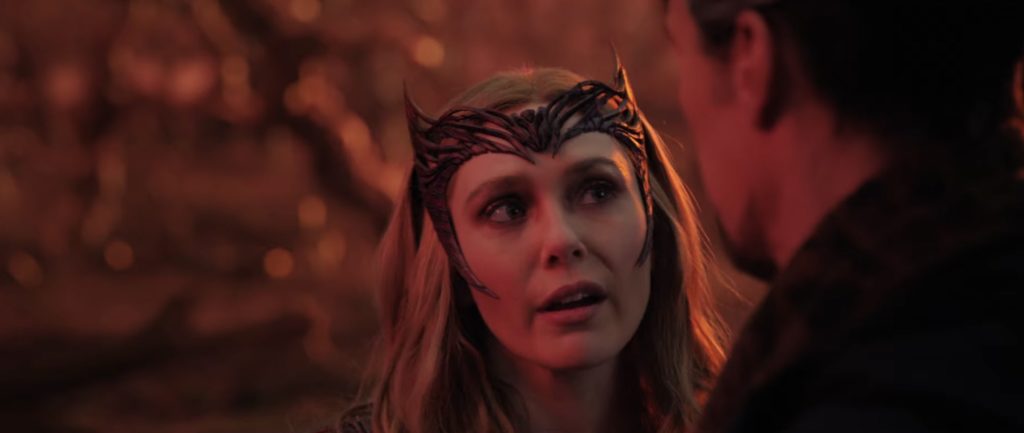
The first thing I noticed about this movie was the opening. The opening has Dr. Strange and America running through a bizarro world set of objects floating in the sky trying to get to some treasure at the end of the path.
I thought… is this really where we are?
In 1981, we had a sequence just like this. Two people heading down a trail trying to get to a treasure. That movie was Raiders of the Lost Ark.
I was thinking, in the 40 years since this scene… have we improved on it? Or have we actually gone backwards? I would argue that we’ve gone backwards. Because the brilliance of Raiders was that everything was clear. We understood the rules (a cave with a bunch of booby traps). We were spatially aware of how the geography worked (it was one straight line). The simplicity of it is what allowed it to thrive.
This was just gobbledy-gook nonsense. I didn’t understand what Dr. Strange and America were running from, what the rules of the world were, the geography. Everything looked fake. And that’s not to say the big papier-mâché boulder in Raiders didn’t look fake. But this looked a special kind of a fake. A non-tangible fake. And that monster looked like digital scrambled eggs.
I don’t mean to be so “old man yells at cloud” here but I would bet you a million dollars that if you sat a dozen ten year-olds down in front of two TVs, one playing the opening sequence from Raiders and the other playing the opening sequence from this movie, that they’d all eventually focus on the Raiders TV.
Going into this movie, I had a simple expectation. If that expectation was met, I’d be happy. If it wasn’t, I’d be bummed. That expectation was that the film exploit the multiverse concept as much as possible. The movie is literally called, “Dr. Strange and the Multiverse of Madness.” But guess what? There is surprising little multiversing.
I thought they were gonna get stuck in a bunch of strange universes and have to find their way back. But outside of seeing a couple of quick lame universes, we end up in a world pretty much the same as our own, and that’s it. No more multiversing! And the final act takes place on some random mountain somewhere. So it didn’t matter WHAT universe we were in. Not gonna lie. Lame choice.
Luckily, the film had two good things going for it and two fun talking points. Benedict Cumberbatch and Scarlet Witch were the good things. Benedict Cumberbatch is endlessly likable. So he was fun. And Scarlet Witch turned out to be a surprisingly formidable villain. I always thought her character was kinda lame. But her psychopathic tendencies gave the villain storyline a bigger punch than it typically has in a Marvel movie.
Talking point #1 is the Illuminati sequence. In retrospect, this sequence was kind of genius. Because it introduces two characters that are really exciting to see in the Marvel Universe – Professor X and Reed Richards (leader of the Fantastic Four). You see these characters and you think, “Whoa! This is what the 20th Century Fox buy got them! We get to see these characters in Marvel movies now!” But then they completely flip those expectations on their head when they kill these titanic characters off. And, of course, it doesn’t matter that they killed them off because we’re in another universe. Those characters are still alive when we go back to earth (and therefore available for future movies). It was the perfect way for Marvel to be able to have its cake and eat it too.
Talking point #2 is Zombie Dr. Strange. I thought Zombie Dr. Strange was cleverly constructed. Somehow it made sense. And I have to give to director Sam Raimi for figuring out a way to get his favorite things – zombies – into a Marvel film in a way that actually worked.
So if I were only grading the movie on everything I’ve talked about above, I’d give it a “worth the price of admission.” Cause it was fairly entertaining. Unfortunately, there was one more element in the film that weighted it down so severely, it plummeted into “awful” territory. I’m of course talking about the character of America.
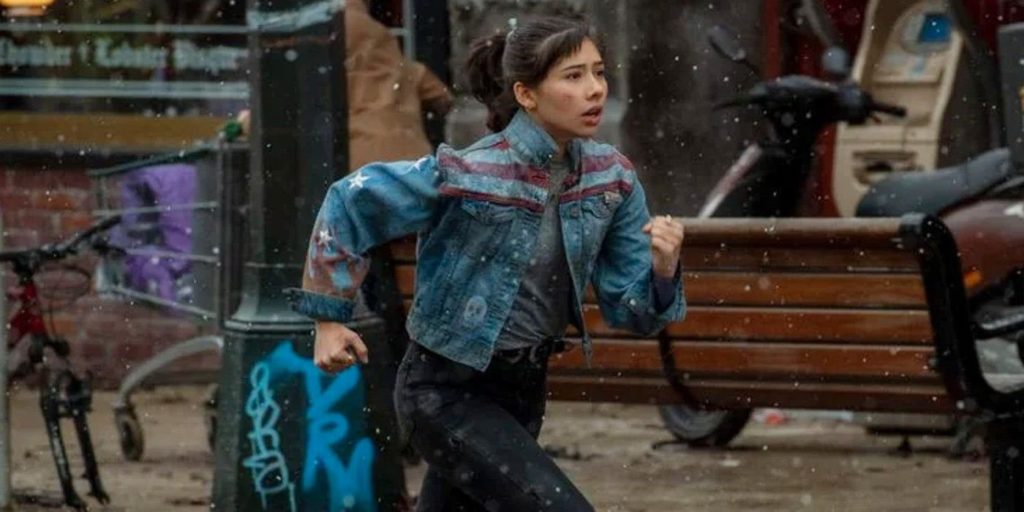 Make it stop! Agh! I even hate that stupid jacket!
Make it stop! Agh! I even hate that stupid jacket!
I have no clue what this girl was doing in the movie. I kept thinking, “Is this one of those weird woke choices that studios are being forced to make these days?” I couldn’t figure out what was steering anyone with half a brain into including this annoying pointless reject of a character.
I thought, “Well maybe she’s there to give the younger audience someone to relate to?”
The problem with that logic is it doesn’t matter what your intentions are as a writer. If you try to force a character into a movie in an inorganic way, nobody’s going to like them. And this character never once felt like she was needed in this movie. And even if you excused that, she was just BORING. She had nothing interesting going on. No powers. No flashy backstory. No compelling inner conflict. Why was she in this movie????

Cause she’s the Jar-Jar Binks of Dr. Strange and the Multiverse of Madness. She’s the reason, when people ask me if they should see this movie, I’m going to say no. She’s straight up a dumb character and shame on Marvel if they put her in here for reasons other than trying to make the best movie possible.
I’m happy that movies like this are getting people back into the theater. But this is a bottom fourth-tier Marvel movie. It’s in the same category as the early Thor films and the Ant-Man sequel. If you have 2 and a half hours to waste, go ahead and see it. Otherwise, wait for the next Marvel offering.
[ ] What the hell did I just watch?
[x] wasn’t for me
[ ] worth the price of admission
[ ] impressive
[ ] genius
What I learned: Don’t pair your hero up with someone just to pair them up with someone. Sure, adding a co-star so that your movie is a two-hander has benefits. Giving your hero someone to bounce dialogue off of eases up the exposition load and allows for a lot more banter. But if the secondary character doesn’t have any interesting juxtaposition to the hero at all (good juxtaposition would be Thor and Starlord)… it’s better to just delete them. A two-hander is not unlike how sexual chemistry works in real life. When you and another person have sexual chemistry, there’s a spark that provides an exciting energy to your interactions. When you don’t, there’s a deadness to your conversation. It lacks impact. Same thing when writing two-handers. If the chemistry isn’t there, drop the second character. Cause Doctor Strange 2 is evidence of what happens when you try to force a two-hander. It’s paaaaaainful.
BONUS: THOUGHTS ON AVATAR 2 TRAILER!
![]()
I thought this trailer was amazing considering that Cameron is clearly only including footage from the first ten minutes of the movie. This isn’t even a traditional teaser. This is whatever precedes a teaser. It’s basically footage set to music. The difference being that the footage is accumulated from ten years of research and development along with a new industry-changing digital technology.
Surprisingly, there isn’t a whole lot of underwater footage. We get some shots of the human base on Pandora, which has gotten a lot bigger. We get some shots of the jungle. We get people swimming just under the surface. Nothing crazy. But the thing that stuck with me the most was the music. It had this traditional etherial sound but Cameron has tweaked it so that the ends of each note slither, like tendrils, into your body, latching onto your soul and shaking it. I know that’s a big statement but it’s true. Cameron is a master and understands that nothing can be left to chance. He makes sure that even the music – something no fan’s been thinking about during Avatar’s decades-long production – is great. That sound alone makes me believe this is going to be an epic story.
If I were to guess what the plot was, I’d say that the humans are trying to exterminate the remaining pockets of Na’Vi resistance, which is why the Na’Vi have moved underwater, since it’s harder for the humans to fight them there. A part of me wishes a third foe would arrive so the humans and Na’Vi had to work together to stop them. But I’m not seeing anything in this trailer that would lead me to believe that’s part of the plot.
I think Avatar 2 is going to be one of those movies that shakes the industry up. Because for the last ten years, Marvels’ been cranking movies out on an assembly line. And they look crappy. Marvel movies work because of the characters, not because you’re like, “Wow, those were amazing special effects.” Then you had Netflix, which was pumping out films too fast for any serious quality control. So the industry has gotten used to these sloppy-looking movies and just shrugged their shoulders and said, “That’s just the way it’s done now.”
Avatar 2 is a movie where every single frame will have been relentlessly poured over by Cameron himself so that it looks beautiful. Audiences are going to be wowed by that and Marvel’s going to have a come-to-Jesus moment where they can’t give us special effects that are indistinguishable from hiring some nameless programmer on Fiver.
And that’s a good thing. Cause if there’s anything Doctor Strange 2 taught me? It’s that Marvel is getting too sloppy. Nothing like a new movie from the master to remind everyone where the bar should be placed. :)
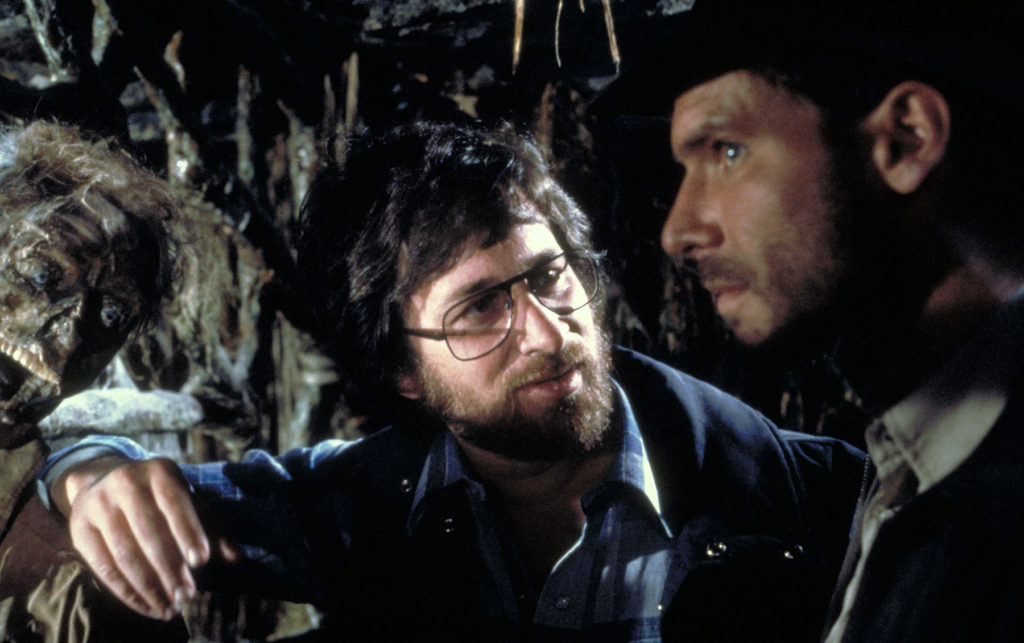
So late last month, a little known E.T. story started making the rounds. Steven Spielberg had finished 1941 and was currently on production of Raiders of the Lost Ark. Like any smart director, he was lining up his next film, E.T., and needed a writer. As luck would have it, he wanted a young writer named Melissa Mathison, who was his star’s (Harrison Ford) girlfriend at the time.
This is where the story gets interesting. Spielberg pitched Mathison the idea for E.T. and Mathison said no, she didn’t get it. I just want to pause here so we can all hear the galactic level record scratch of a writer SAYING NO TO STEVEN SPIELBERG! In Mathison’s defense, she had a good reason for the rejection. She’d just quit screenwriting.
Between her two lone credits, The Black Stallion and The Escape Artist, Mathison had decided that screenwriting was “too hard.” In retrospect, Mathison’s early retirement never stood a chance. Spielberg went straight to Ford, asked him to put in a good word for him and E.T., and Mathison eventually came around to write the film. For all involved, it was ‘happily ever after.’
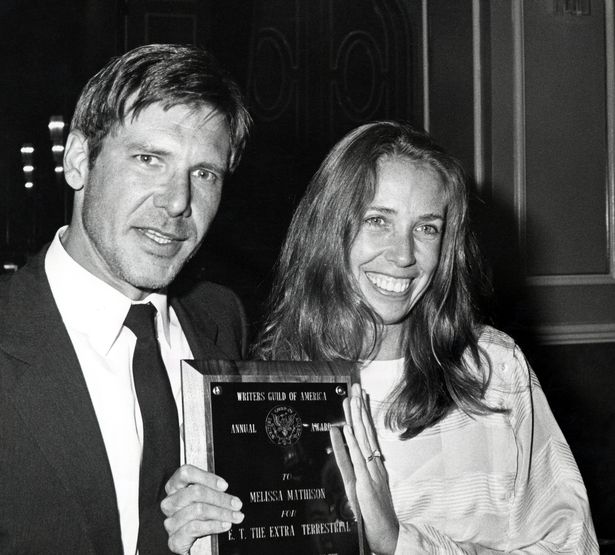
However, Mathison’s reason for the initial rejection stuck with me. She quit screenwriting, at just 31 years old and with two produced credits, because it was “too hard.”
“Too hard.”
Is screenwriting “too hard?”
It sure seems easy when you’re watching a bad movie. “I could write a better movie than that!” somewhere north of 100 million moviegoers have said over the years.
But anyone who’s spent even three years in the game knows how deceptively difficult screenwriting is.
But is it too hard?
Is it not worth the trouble?
A while ago I was developing a sports script with a writer and we’d spent countless hours and many drafts trying to figure out our main character. It seemed like every new draft, we tried a new iteration of the character. After about draft 7, the character finally started to take shape. We finally felt like we understood him, and the rest of the script came together nicely as a result.
Then, around draft 10, as we were writing the big final game, it occurred to us that the ending would be MUCH BETTER if our main character made a major sacrifice at a critical point late in the game. We’re talking, the climax went from being a 6 out of 10 to a 9 out of 10. The change was a no-brainer. We had to do it.
But here was the problem. Our main character was not someone who sacrificed. Nowhere in the script was this built into the character so that when the moment came, it would make sense for him to sacrifice anything.
What we realized was, if we were to write this new direction into the climax, it would mean completely redesigning the character from the ground up. He’d have a totally different personality and demeanor. Which would make all of his actions and dialogue different.
On top of that, we’d designed the love interest to be in stark contrast to our main character. She was his opposite. By changing the main character into this new version, he was no longer the opposite of the love interest. Which meant – as I’m sure you’ve already figured out – we’d have to completely rewrite her as well! Change her from the ground up so that this new version of her was opposite to the new version of him.
So now we had to sit down and make a difficult decision. Do we make all these changes, redesigning our two main characters from the ground up, just to support this awesome ending? Or do we continue to try and find another great ending, despite the fact that we’d spent the previous six months doing just that and failing?
Is screenwriting hard?
If you’re doing it right, you bet your ass it’s hard.
So I get Melissa Mathison. I totally understand where she was coming from. Because a script can feel like a never-ending battle. In a way, you never truly write the script you want. You either run out of steam or, if you’re one of the blessed few who have made it to the professional ranks, they need to start shooting.
With that said, I have found some tips and tricks over the years to make the experience of writing screenplays a little easier. If you incorporate these ten tips, you’re going to keep more hairs on your head, and severely lower your chances of having a heart attack.
Outline – One of the things that causes so much pain in screenwriting is all the drafts. You’re always having to fix some aspect of the script with a rewrite. You can knock about 3-4 drafts off that process if you outline. In particular, outlining helps you figure out your structure ahead of time, which means spending less drafts fixing your broken structure.
Make sure you understand your 2-3 main characters as clearly as possible going into the script – The hardest thing about screenwriting is getting the characters right. That’s because people are complex and creating fictional versions of them that feel authentic takes an incredible amount of skill. Therefore, if you have a great feel for your characters going in, you eliminate a lot of headaches later on. Rocky is an underdog who doesn’t know if he has what it takes. Alan in The Hangover is the most socially unaware overly opinionated man in the universe. Guy (Free Guy) is tired of following the same old routine every day and decides he’s going to commit to doing things outside his comfort zone. Just like these examples, try and distill your character down to a single clear sentence. If you can do that, you should be good.

Keep your story simple – I read a lot of “everything-and-the-kitchen-sink” scripts where the writer is shooting themselves in the foot by giving themselves a massive amount of variables to keep track of. The reality is, most of the best movies have a simple setup and execution. Small character count. Clear goal. Etc. By keeping the variables down, you’ll keep the stress level down.
Be passionate about your concept – As much as I talk about finding the best idea you can come up with and writing it, that’s worthless advice unless you love the idea. As most of us here can attest to, there is nothing worse than writing a script you’re only kinda into. Every draft feels like five drafts. These scripts take way more out of you and will definitely accelerate any doubts you have about whether screenwriting is for you. Love that idea like you love your family.
Write lean – If you tend to write 4-line paragraphs, aim for 3 lines. If you tend to write 3-line paragraphs, aim for 2 lines. Writing lean means there are less words to edit and since we’re all writers and obsessive about making every little sentence perfect, the less words you have to wade through, the less hassle writing is going to be. As a bonus, your script is easier to read through.
Don’t deliberately make the process overwhelming – You’ve got a document detailing all the characters in your script, a document for your potential story ideas to use, you’ve got your outline, an excel spreadsheet tracking when and where every character appears, you’ve got a document for alternate scenes, a document for deleted scenes, a document explaining the alien language spoken in your script… If all these things make you genuinely happy, fine. But, at a certain point, we make the process of writing a script so cumbersome, that we start to hate the idea of working on it. It’s fine to get detailed. But don’t get carried away.
Focus on the things you should do, not the things you shouldn’t – I know reading this site can sometimes feel like a never-ending mine field of screenwriting bombs to avoid. But if all you’re doing is focusing on mistakes to avoid, you can’t write freely and you won’t have fun. You are always going to do things in your script that “shouldn’t be done,” like yesterday’s choice to make the protagonist a kidnapper. But as long as you feel it’s right for your story, embrace it and don’t look back.
Talk it out – Find someone in your life who will listen to you talk out the problems in your screenplay. One of the reasons writing is so hard is that we contain ourselves to just our brain and run the same problems through that calculator over and over and over again with no result. Of course writing starts to feel impossible (and drives you crazy!). Sometimes you need to talk your ideas out with someone, even if they’re not a screenwriter. By forcing yourself to explain the issue to a third party, you see the problem through their eyes, and that alone helps you find a solution.
Focus on the stuff that matters – Stop stressing about that exposition scene on page 70 where you’re trying to make each dialogue line perfect. Instead, focus on the things in your script that have the biggest impact on the read. The first ten pages, the first act turn, the midpoint shift, the story’s big set pieces, the hero’s low point, any major twist scene, the climax. That’s where you should be placing 75% of your focus. You don’t need to drive yourself crazy over those smaller scenes where the characters reveal some mildly significant backstory about themselves. In the grand scheme of a screenplay, those scenes are way down on the priority list.
Be easy on yourself – Screenwriting is hard no matter what you do. It’s baked into the pursuit. However, I think that’s why we do it. We know that in those few moments where we do crack the code and write a good script, we’ve achieved something amazing, something that very few people on the planet can do. Who cares if you achieve something that’s easy, right? You only feel a sense of accomplishment when you’ve achieved something that’s hard. Maybe even too hard. :)
What’s your take on this? Is screenwriting too hard?
Having concerns about your logline or screenplay? Let me help you. Logline consults are just $25 (and if you buy 4, you get a 5th for free). I also provide consultations for each stage of the screenplay journey: outline ($99), first 10 pages ($75), first act ($149), full pilot ($399), full screenplay ($499). I’ve read thousands of screenplays, including all the ones that get produced and all the ones that don’t. There’s no one better equipped to help you improve your script than me. If you’re interested in getting a consultation, e-mail me at carsonreeves1@gmail.com and let’s work together!

